
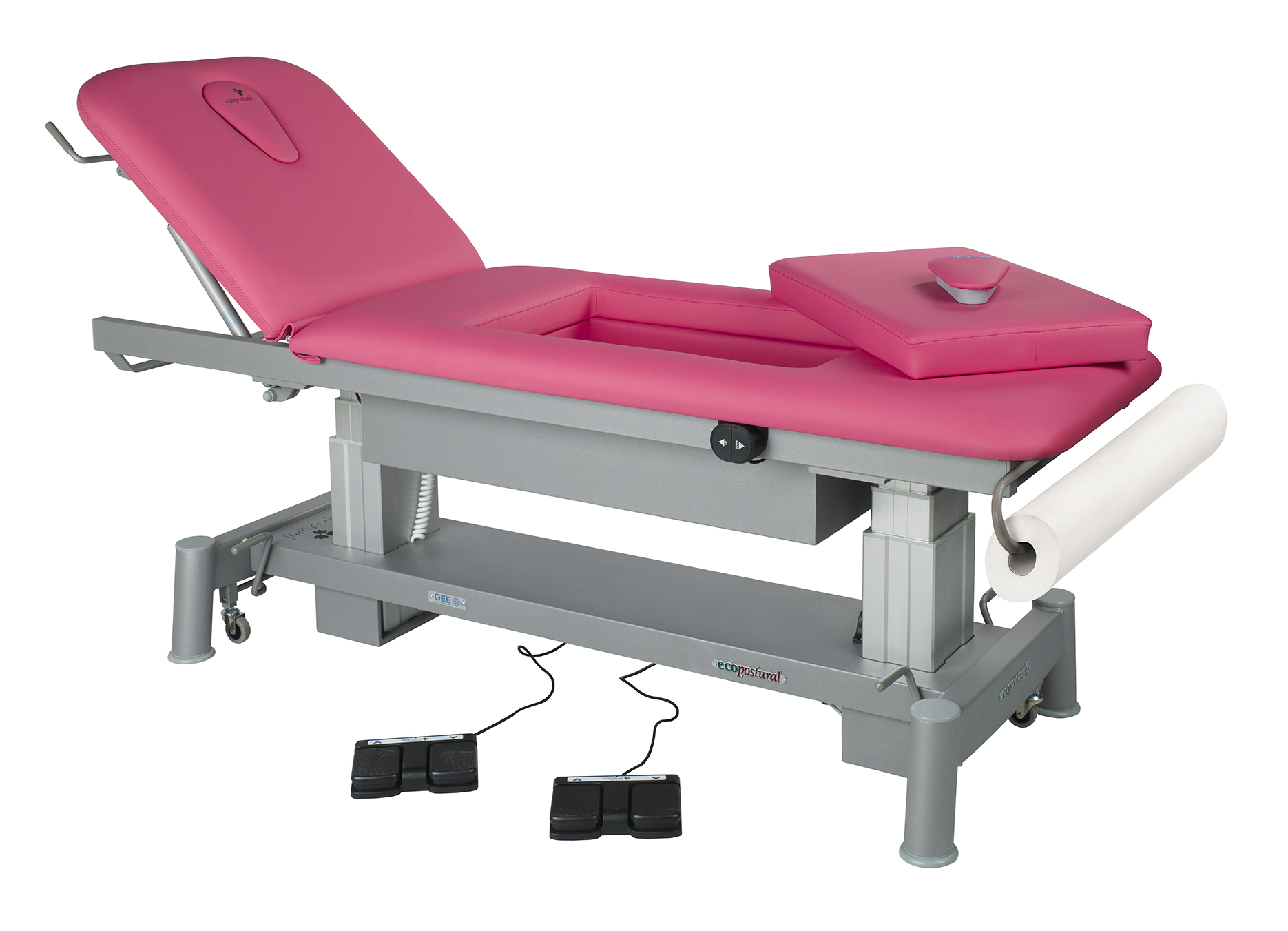
The C6880 examination table: a functional design for larger body sizes
7 October 2025.
Author/s: Ricard Barberá-Guillem, Tatiana Rodríguez Rodríguez, Edgar M. Chacón Montiel, Laura Martínez Gómez.
Instituto de Biomecánica (IBV)
For patients with a prominent abdomen, receiving therapeutic treatment on a conventional examination table can present difficulties. To address this issue, ECOPOSTURAL has developed the C6880 table, which has been specifically designed to improve the comfort and safety of such patients.
The Instituto de Biomecánica (IBV) contributed its expertise in the field of medical device product evaluation and validation to the design, development and certification of this solution. Comfort and usability tests were conducted, using both subjective methods, such as user surveys, and objective methods, such as measuring contact pressure.
The study methodology was approved by the Ethics Committee of the Universitat Politècnica de València. Both pregnant women and men with prominent abdomens preferred the new examination table to conventional tables.
INTRODUCTION
Treatment of certain areas of the back often requires patients to lie face down, a position that can prove difficult for those with a distended abdomen. In the case of pregnant women, assuming this position becomes increasingly difficult as their pregnancy progresses. However, men with large abdomens face the same problem and may find that they have restricted access to the benefits of appropriate interventions or psychotherapeutic treatments.
Adopting this position makes it easier for the therapist to manipulate the patient’s back safely and allows the patient to derive the full benefits of the therapeutic massage. The benefits for pregnant women have been well documented: pain relief, reduced stress and easier childbirth, etc. In overweight men, it has been shown that interventions of this type can improve their mobility and circulation[1].
ECOPOSTURAL has developed the C6880 examination table to address this issue. This table features a patented pneumatic system that allows therapists to adapt it to patients between 1.5 and 2 metres tall, with a maximum weight of 250 kg, which covers the vast majority of potential patients.
The C6880 examination table is designed for use by physiotherapists and similar professionals – see Figure 1. Although it functions like a conventional examination table, it has the added advantage of having a removable central section. This feature allows the therapist to create a cavity containing an inflatable cushion that adapts to the shape of the patient’s body once they are lying on the table. Depending on their morphology, this facilitates the positioning of the abdomen, breasts or head, providing greater comfort.
The innovation of this solution was recognized by both the jury and the audience at the French fair Rééduca, focused on the field of rehabilitation and physiotherapy, in its 2024 edition. The jury, in particular, highlighted its ‘creative and innovative character, useful for both patients and therapists.
The IBV study evaluated the usability and comfort of the C6880 table for pregnant women and men with pronounced abdomens. See Figure 1. The aim was to validate the hypothesis that its specific design increases patient comfort and facilitates therapist access safely and effectively. This study was part of a wider collaboration between ECOPOSTURAL and the IBV which involved conducting tests and preparing the technical documentation required by the EU Medical Device Regulation (MDR) for the examination table to obtain CE marking as a medical device. ECOPOSTURAL is participating in this project as the company responsible for the product, while the IBV is acting as a collaborating organisation involved in tasks such as evaluation, validation and technical development in the field of ergonomics applied to medical devices.
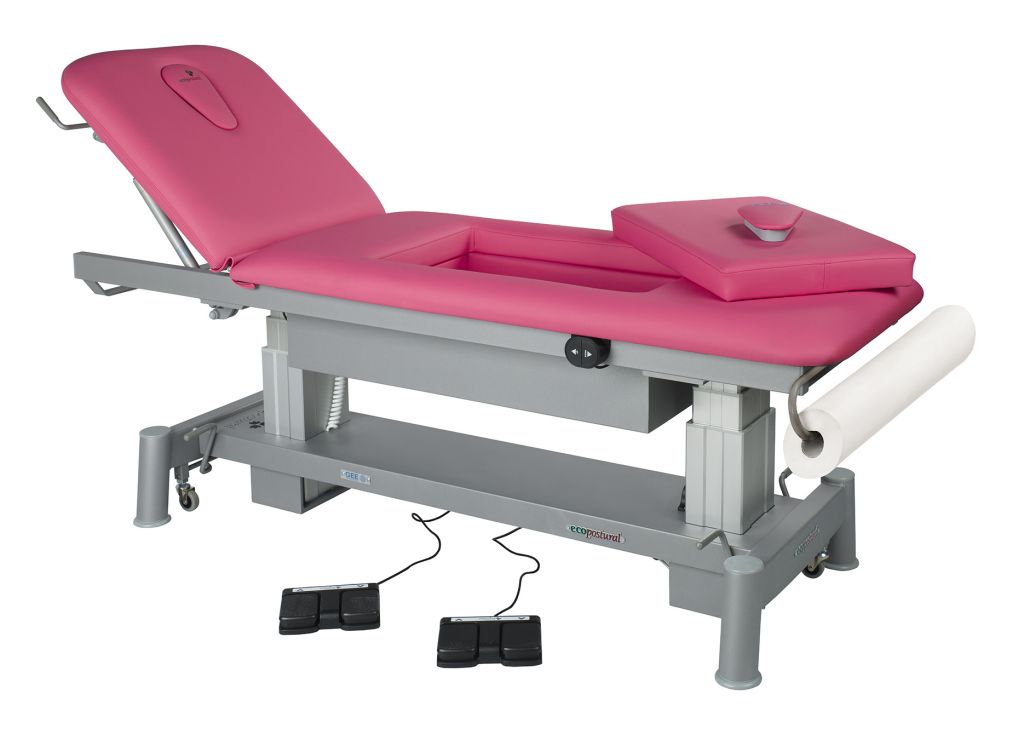
Figure 1. The Ecopostural C6880 examination table
MATERIAL AND METHODS
Six people took part in the study: four women in their third trimester of their pregnancy with no prior complications, and two men with pronounced abdomens. All had recently received physiotherapy. The methodology involved gathering anthropometric data (sex, weight, height and abdominal perimeter) and measuring pressure in the abdominal area by means of the Xsensor pressure measurement device. This device consists of a blanket-like mat that records pressure from the lower abdominal area up to the chest. The participants also filled in a questionnaire regarding comfort and usability. The tests were carried out in a single session at the IBV, in accordance with rigorous inclusion and exclusion criteria. Special attention was paid to the safety of the pregnant women. The study was approved by the Ethics Committee of the Polytechnic University of Valencia.
All evaluated parameters, with the exception of the presence of discomfort (With discomfort / Without discomfort) were assessed using a five-level scale: 1. Totally agree / Very comfortable, 2. Agree / Comfortable, 3. Indifferent / Neutral, 4. Disagree / Uncomfortable, 5. Totally disagree / Very uncomfortable.
RESULTS AND DISCUSSION
CHARACTERISATION OF USERS PARTICIPATING IN TARACTERIZACIÓN DE LOS USUSARIOS PARTICIPANTES EN EL ESTUDIO
Table 1 contains a summary of the anthropometric characteristics of the study participants.
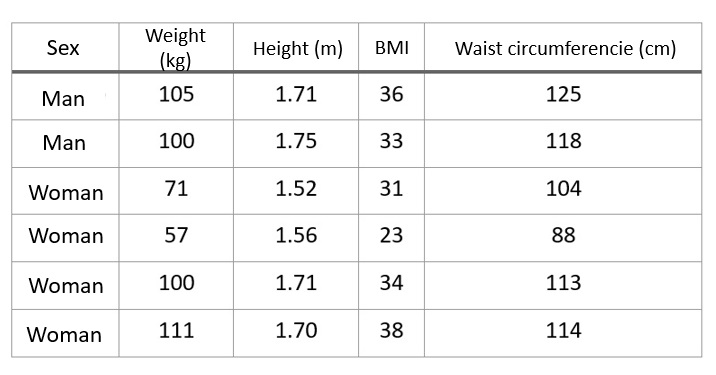
Table 1. Anthropometric characteristics of the participants.
EVALUATION OF COMFORT AND FUNCTIONALITY
The table was rated very highly in terms of overall comfort, with 100% of participants saying it was “very comfortable” (33%) or “comfortable” (67%). The support for prominent abdomens was considered “totally adequate” by 83% of the participants and “adequate” by the remaining 17%.
Among the six participants (four women and two men), 67% reported no discomfort during use. The remaining 33% — the shorter women — reported localized discomfort in the shoulders or collarbone. Regarding the ease of getting on and off the examination table, all participants rated it positively: 17% described it as ‘very easy’ and 83% as ‘easy’
Participants also highlighted the stability and safety of the treatment table. 83% “totally agreed” and 17% “agreed” that it was very stable. With regard to positioning, 83% said that the table enabled them to adopt a suitable posture without causing any strain. The same percentage rated the table as better or much better than conventional tables.
Finally, all participants said they would feel comfortable during a lengthy physiotherapy session. 50% said they would feel “very comfortable” and the other 50% “comfortable”.
The results of these evaluations can be seen in Figure 2, along with the details of the questions asked.
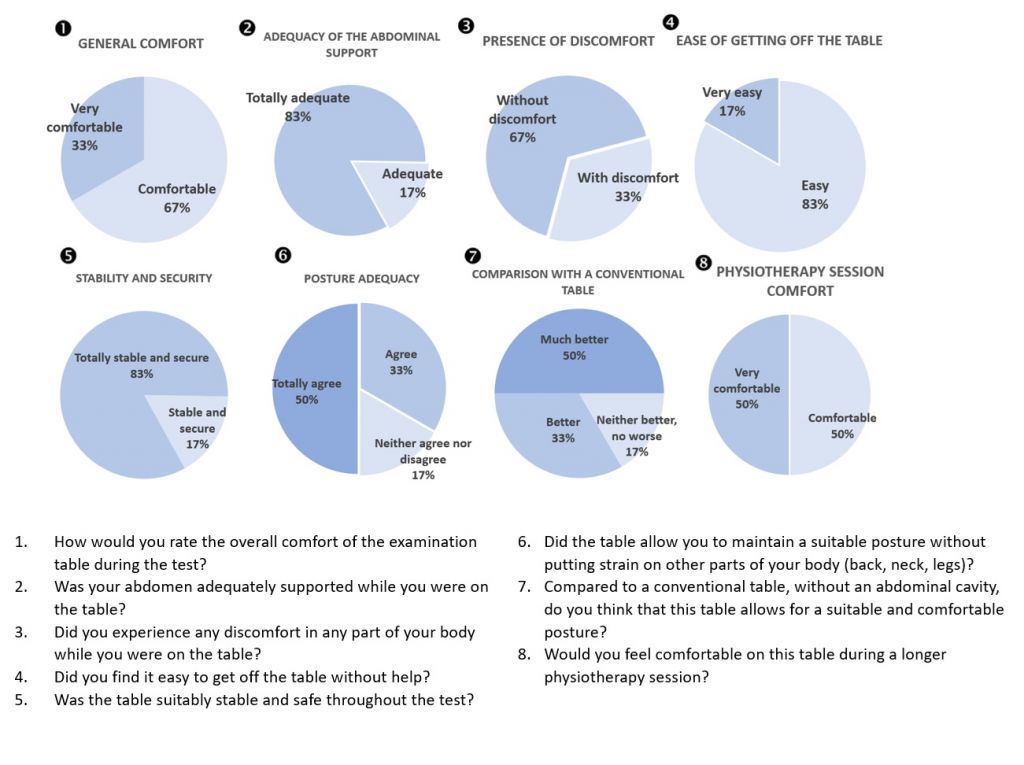 F
F
Figure 2. Results of the C6880 examination table usability and comfort evaluation.
RESULTS OF THE ABDOMINAL AREA PRESSURE MEASUREMENT
Table 2 shows the maximum and mean pressure values recorded in the abdominal area. The mean pressures are below 32 mmHg, which is normally considered a critical reference point for the onset of pressure ulcers if maintained over prolonged periods. On the other hand, the maximum pressures are within the expected range for hospital bed mattresses. These were recorded outside the abdominal area, primarily close to the edges (lower abdomen or hip).
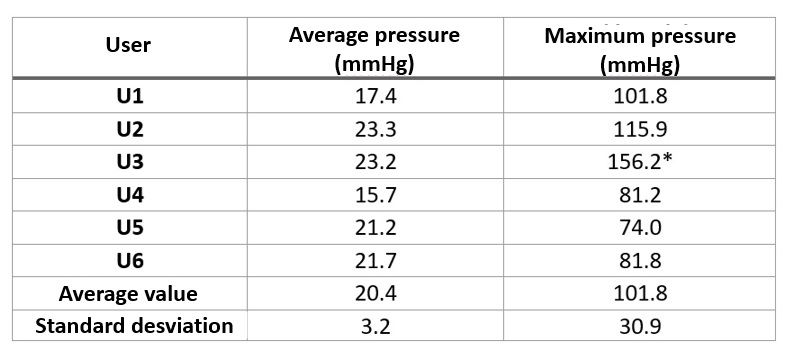
Table 2. Maximum and mean pressure values in the lumbar area
(*) This value was reached at the lower edge of the abdominal cavity of the examination table. Pressure values in the abdominal area, i.e., the area of risk, were similar to those of the other participants.
CONCLUSIONS
It has been confirmed that the ECOPOSTURAL C6880 examination table provides patients with prominent abdomens with a high degree of comfort and suitable postural support. The results of the study support the initial hypothesis and demonstrate that the table enhances the practice of physiotherapy in a safe and comfortable manner. The most highly valued aspects included the way the table can be adapted and personalised, the uniform distribution of the patient’s weight, and the reduction in strain on the dorsal and abdominal regions thanks to the improved back position and the enhanced adjustability of the support facilitated by the abdominal cavity. This is also reflected in the pressure values achieved in these areas.
Opportunities have been identified that will make it possible to continue to improve the product design, for example, the adjustment of pressure and the facial cavity. These opportunities mean that the collaboration between ECOPOSTURAL and the IBV shall continue for some time to come.
This study is part of the technical and clinical evaluation process required by the EU Medical Device Regulation (MDR) for examination tables to obtain CE marking as medical devices. The results obtained in this study, together with the technical documentation and the tests conducted the IBV’s advanced Medical Lab facilities (https://med-lab.ibv.org/), confirm that the product meets all applicable essential safety and performance requirements.
BIBLIOGRAPHY
[1] Field T, Figueiredo B, Hernandez-Reif M, Diego M, Deeds O, Ascencio A. Massage therapy reduces pain in pregnant women, alleviates prenatal depression in both parents and improves their relationships. Journal of Bodywork and Movement Therapies. abril de 2008;12(2):146-50.
[2] El-Hosary EmanA, Abbas Soliman HF, El-Homosy SamahM. Effect of Therapeutic Massage on Relieving Pregnancy Discomforts. IOSR. abril de 2016;05(04):57-64.
[3] https://plussizepick.com/massage-for-overweight-and-obese-people-advantages-best-tips/
https://www.integrativehealthcare.org/mt/massage-for-obese-clients/
AUTHOR’S AFFILIATION
Instituto de Biomecánica de Valencia
Universitat Politècnica de València
Edificio 9C. Camino de Vera s/n
(46022) Valencia. Spain
HOW TO CITE THIS ARTICLE
Author/ss: Ricard Barberá-Guillem, Tatiana Rodríguez Rodríguez, Edgar M. Chacón Montiel, Laura Martínez Gómez (16 of September of 2025). «The C6880, examination table: a functional design for larger body sizes». Revista de Biomecánica nº 72. https://www.ibv.org/en/latest-news/the-c6880-examination-table-a-functional-design-for-larger-body-sizes/



